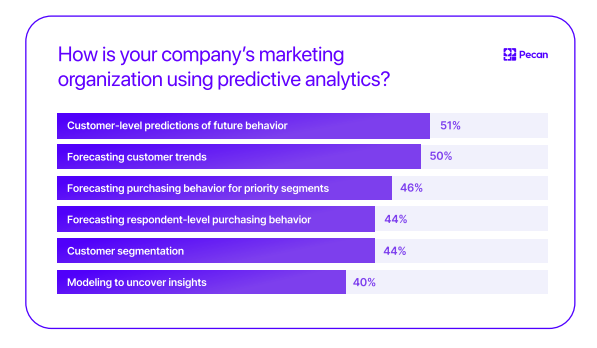In a nutshell:
- Traditional marketing analytics only provide a limited view of past data, lacking insights into the "why" and "what's next."
- Predictive analytics offers the power to anticipate future outcomes and make data-driven decisions.
- Predictive modeling can improve campaign performance, customer retention, and revenue growth.
- Marketing mix modeling helps optimize budget allocation across various channels for maximum ROI.
- Embracing AI-powered predictive analytics allows marketers to proactively address business problems and gain a competitive edge.
Let's face it, as marketing professionals, we're practically swimming in data. From customer experiences to social media engagement, web traffic metrics, and email open rates — you name it, we're tracking it. Our marketing analytics tools are working overtime to help us make sense of this massive (and sometimes overwhelming) influx of data.
This is largely because we've bought into the idea that more data equals more insights. And to a certain extent, that's true. After all, these datasets provide a wealth of knowledge about our past marketing initiatives, painting a relatively clear picture of what worked and what didn't.
But here's the catch: Our usual method of crunching these numbers, typically through descriptive analyses (historical data), offers a limited view. While these rear-view insights tell us what happened (like how many people clicked on our latest promotional email or which social post drove the most traffic last week), they don't offer much in the way of the “'Why?” or “What should I do next?”'
The incomplete story of your marketing analytics
You may be thinking, “But my current analytics practices seem to be working fine.” They might be working for now, but today's marketing conditions are changing quickly — plus, you don’t know what you might be missing without evaluating all your options. For example, how will the rise of generative AI impact your SEO efforts? Relying solely on historical data might leave you trailing.
It's like trying to drive a car by only looking in the rear-view mirror — you're trying to make a decision on where to go next by looking behind you. While you're busy analyzing last quarter's data, other companies are well into their AI adoption journey, leveraging predictive modeling to anticipate customer behavior and guide proactive strategies.
What happened in the past is a poor indicator of what’s likely to happen in the future.
Our State of Predictive Analytics in Marketing survey revealed an interesting problem. Despite gathering customer data, 84% of marketers admitted they found it challenging to leverage this information for daily decision-making. Clearly, the abundance of data isn't translating into actionable insights as effectively as it should.
Source: State of Predictive Analytics in Marketing 2022, Pecan AI
Advanced marketing analytics techniques
Marketing analytics is the practice of measuring, managing, and analyzing data to improve marketing effectiveness and optimize marketing strategies.
Organizations can utilize four key marketing analytics methods to gain valuable insights and make data-driven decisions. The four key methods of marketing analytics are descriptive analytics, diagnostic analytics, predictive analytics, and prescriptive analytics. (We dive deeper into those types of analytics in a separate blog post.
Companies can uncover customer behavior patterns, market trends, and campaign performance concerns by analyzing marketing data. But it's important to note that advanced marketing analytics techniques and tools do more to extract valuable insights from data, leading to increased revenue growth and helping companies identify new growth opportunities.
One important aspect of advanced marketing analytics is monitoring the success of marketing channels and campaigns. By using advanced analytics methods, marketers can fine-tune their campaigns and allocate resources effectively. This approach allows them to identify the most profitable campaigns and determine the channels used by customers and prospects. With access to actionable data, marketers can make informed decisions about the future and spot emerging trends earlier.
Advanced marketing analytics enables Chief Marketing Officers (CMOs) (and those aspiring to become CMOs) to take more informed action on their data, leading to more effective campaigns and more reliable insights. This ultimately drives revenue growth and business success.
The missing puzzle piece in your marketing analytics techniques
Consider this: Instead of solely analyzing what’s already happened, what if you could anticipate what's likely to occur in the future — and then make decisions based on that information? What if your digital marketing campaigns were guided by predictions of customer behavior over the next 30, 60, 90, or even 180 days?
That's the power of predictive analytics. Instead of relying on “best guesses” about the future based on historical data, digital marketing teams can use these more accurate predictions, based on thousands (or billions) of data points and advanced machine learning, to inform their campaigns.
Predictive analytics is a problem-solving approach that looks at historical patterns to generate informed predictions. It uses data, statistics, and machine learning techniques to build mathematical models that can generate predictions about things likely to happen in the future.
By leveraging this AI-driven technology, you can — among other use cases — far better anticipate campaigns' likely return on ad spend (ROAS) and more accurately allocate your budget. No more shooting in the dark, hoping for the best. Instead, you can make informed, data-driven decisions that yield better results.
The power of predictive modeling in marketing analytics
Let's explore how predictive modeling can impact your marketing strategy.
Predicting customer behavior for optimal retention and revenue
Understanding your customers' behavior forms the foundation of any successful marketing strategy. However, with advanced data analytics techniques like predictive modeling, you can take this understanding to an entirely new level.
Our State of Predictive Analytics in Marketing report indicated that 51% of companies surveyed use predictive analytics to understand their customers on a deeper level and predict future behavior. Meanwhile, 50% also use it to forecast customer trends.
Source: State of Predictive Analytics in Marketing 2022, Pecan AI
Let’s take a look into just how these predictions are being used to improve campaign performance.
Predictive modeling: a proactive tool
Predictive modeling uses past data patterns to foresee future outcomes — for example, predicting customer churn, anticipating customer LTV (lifetime value), and more effective cross-selling and upselling.
From acquisition to retention
While acquiring new users is always exciting, let's recognize the goldmine that is your existing customer base. It's generally more cost-effective and beneficial in the long haul to keep current customers coming back. Why? Because maintaining established relationships usually requires fewer resources than starting new ones.
And this is where predictive modeling shines. It's like an early-warning system that alerts you when customers think about heading for the exit. It's about turning insight into action, maintaining customer loyalty, and saving marketing dollars.
Predicting churn enables you to identify which customers are likely to leave and the reasons behind their decision. With this knowledge at your fingertips, you can intervene proactively with personalized offers or messages that resonate with individual customers.
Growing customer relationships (and revenue)
But the benefits of predictive analytics extend beyond just cost-saving — it's also a relationship-building and revenue-growing strategy. Predicting customer LTV (lifetime value) helps you pinpoint your ideal customer, optimize your marketing efforts, and enhance and personalize the customer experience at every turn.
Data science methods are far better at parsing complex data and determining how variables interact to shape different outcomes. By addressing potential issues before they escalate into reasons for leaving, you show your customers that you value them and their business. This nurtures customer loyalty and can transform one-time buyers into lifelong brand advocates with recurring (and growing) purchases. In other words, you’ll successfully achieve meaningful cross-selling and upselling as you deepen the customer relationship and provide increasing value.
Guiding larger strategic decisions
Predictive models don't just predict behavior — they can also help identify the factors influencing it. This data can inform and guide your larger strategic decisions. For example, if the model reveals that a high number of customer service interactions significantly impacts churn rates, it might be time to reassess and enhance your customer service operations.
Maximizing ROI with marketing mix modeling
Predictive analytics can also help you further optimize your marketing strategies by helping you understand attribution on a granular level. In the complex online and offline marketing landscape, one of the toughest ongoing marketing challenges is the effective allocation of budget across various channels.
Fortunately, predictive modeling, specifically marketing mix modeling (MMM), can help steer this process toward optimal results. With 83% of marketers agreeing that demonstrating quantifiable ROI for campaign and channel performance is at least somewhat challenging, the need for a better understanding is vital.
Source: State of Predictive Analytics in Marketing 2022, Pecan AI
Marketing mix modeling quantifies the impact of spending across diverse marketing channels, including online and offline, acting as a strategic roadmap for budget allocation. Instead of relying on instinct or previous experiences, marketers can leverage this powerful predictive tool to simulate different budget scenarios and predict their outcomes.
While MMM is a statistical model that businesses have used for decades, the power of machine learning helps provide much faster and more accurate insights as these models can now use the power of AI to analyze billions of data points to provide actionable insights.
Simulating for success
By simulating the effects of changing the marketing budget allocation among these channels, you can gain invaluable insights into where your investment will yield the highest return on investment (ROI). This data-driven approach allows for a proactive and precise planning process that optimizes resources and enhances your marketing effectiveness.
Beyond budgeting: a comprehensive approach to marketing success
But predictive analytics isn't just a tool for budgeting. It's an absolute game-changer with far-reaching implications for your entire marketing operation, touching every phase from planning to reporting.
Data-driven planning
Stop trying to get a crystal ball to work — predictive analytics is far superior as it offers a clear, data-driven view of the future. It empowers marketers to create comprehensive campaign roadmaps that anticipate future trends and customer behaviors, setting the stage for success from the outset.
Maximizing ROAS
Ultimately, predictive analytics enhances your ability to make precise, data-informed marketing decisions that maximize your return on ad spend (ROAS). It aids in identifying potential bottlenecks, avoiding expensive mistakes, and investing every marketing dollar wisely to drive maximum value.
Embracing the AI-powered future of marketing analytics techniques
Traditional marketing analytics, while valuable, only paint a partial picture, often keeping you rooted in the past and not optimized for the future. But leveraging this powerful tool requires accessible predictive analytics. After all, learning complex coding languages to build machine learning models isn’t really feasible for most marketers. You need to move away from cumbersome, complex data science tools to more user-friendly, low-code platforms that put the power of predictive modeling within the reach of everyday marketers.
Low-code predictive modeling solutions can help unearth patterns and insights that help you proactively address business problems, helping prepare your marketing strategies in advance for what customers are most likely to do. The future-focused approach lets you look beyond the horizon and steer your marketing strategies accordingly to gain a competitive edge.
With predictive analytics, you're not just predicting the future but mastering it.
Unlock your business's full potential with Pecan AI’s predictive marketing analytics techniques — schedule a demo today to see the power of AI in action.























